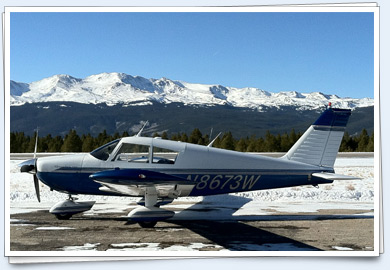Training Tips The first priority 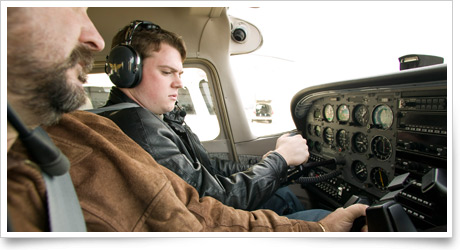 What is the first thing you’d do if a passenger became ill during a flight? What’s the correct first reaction if you see a low oil-pressure indication or experience an inadvertent cloud penetration? What if the baggage door pops open on takeoff, or if the engine suddenly begins to crackle and sputter during a night cross-country? What is the first thing you’d do if a passenger became ill during a flight? What’s the correct first reaction if you see a low oil-pressure indication or experience an inadvertent cloud penetration? What if the baggage door pops open on takeoff, or if the engine suddenly begins to crackle and sputter during a night cross-country? In all the cases described above, the same response applies: Fly the airplane. Easy to say down here on the ground. More of a project to actually have the discipline necessary to keep control, and divide your attention between the one flight requirement that never changes regardless of the situation—maintaining positive aircraft control—and any problem that has arisen. Aircraft accident reports continue to attest that this is one flight challenge that pilots don’t always meet. That’s more unfortunate because aviators have traditionally had a nice head start on other motor vehicle operators in learning about the danger of distractions. When the National Transportation Safety Board made news recently with a forceful statement about the distractive dangers of cell phone use by drivers, the headline-grabbing warning probably came as no surprise to student pilots, whose training—and flight testing—spotlights preparedness for dealing with “realistic distractions.” Not only that, but applicants are forewarned to expect to be baited with a realistic distraction during the flight test. Don’t confuse the need to divide attention between multiple piloting tasks with being distracted. It’s when that ability is overcome by stress or confusion that things start to unwind. For example, intent on maintaining altitude in rough air, the pilot fixates on the altimeter and wanders off course, or misses a critical radio call. Rattled by a poor approach, the pilot forces the aircraft onto the ground at too high a speed and loses control (instead of executing a go-around). Novices aren’t the only victims. An experienced jet crew was distracted by a baggage door coming open after takeoff, with an accident resulting. Here’s a tip for keeping distractions at bay: Whenever you face a challenging moment in flight, or practice an emergency procedure, or are simply answering an instructor’s question about how you would handle a flight scenario, remind yourself aloud that the first step is to “Fly the airplane.” That simple reminder could pay big dividends some day when it really counts. Flight Training News Young Eagles scholarship recipients announced EAA’s Young Eagles Program announced on Dec. 21 the recipients of four flight training scholarships offered to high school students. Christopher Cecil of Mariposa, Calif., and Elijah Young of Ashland, Ohio, each received $7,500. Richard Ramunno of Eagle, Colo., and Kelsey Scheppers of Holts Summit, Mo., each received $1,500. Eligible students completed the majority of the online Sporty’s Complete Pilot Training Course, and those who received the $7,500 scholarship had completed the FAA knowledge test. Is there a right way to change transponder codes? You know to change transponder codes when ATC requests it, but is there a recommended technique for doing so? Some pilots prefer to switch their transponder to standby mode before changing codes, but as it turns out, that may not be the preferred method. Listen to the latest installment of the Ask ATC series from the Air Safety Institute as a controller explains how pilots should change transponder codes and why.  | You didn’t get where you are today by standing on the sidelines when opportunity knocks. And opportunity is knocking right now at Cirrus on the world’s leading personal aircraft. There are incredible time sensitive tax incentives that can offer you up to 100% depreciation in Year I based upon your business use of the aircraft. But you have to act this year, before December 31, 2011 to take advantage of this capital preservation opportunity. cirrusaircraft.com | Va. flight school adds sport pilot training With the addition of a Cessna 162 Skycatcher to its fleet, Aviation Adventures at Warrenton-Fauquier Airport in Warrenton, Va., said it is offering sport pilot training. Private pilot training also can be conducted in the Skycatcher, which rents for $110 per hour wet. The Cessna 162 joins a fleet of three Cessna 172s and a 150. Texas flight school to train international military students US Aviation Academy in Denton, Texas, expects to train up to 200 international students under an $11.7 million contract with the U.S. Air Force. The school will provide primary flight training for students from Nigeria, Afghanistan, Kuwait, and Japan. Four students from Nigeria and two from Afghanistan completed training in 2011. After primary training, students continue with 90 hours of basic training in a T-6 at a U.S. Air Force base, and then 105 hours in a C-12, T-1, or T-38, depending on what they will fly for their own military.  | Your IFR rating in 10 days at your location … IFR finish-up in as little as 3 days! Professional teachers, specialized curriculum. IFR specialists for 30+ years. Whether flying G1000, Avidyne Entegra, Aspen, Cirrus Perspective or analog instruments, our instructors have the experience. Put “Instrument Rated” on your calendar NOW. 800-435-9437. Already Rated, but rusty? Our IFR Safety Course will get you current and make you a safer pilot. www.iflyifr.com | Training Resources Is 2012 the year that you will become a certificated pilot? Let AOPA help you reach your goals. Whether you’re just starting out in flight training and looking for an instructor, finishing up your solo cross-countries, or prepping for a checkride, we can help you! See the Resources tab on the Flight Training website for specific tools crafted to your phase of training. Did you know that student pilots who join AOPA are three times more likely to complete their flight training? Membership includes unlimited access to aviation information by phone (800/USA-AOPA, weekdays from 8:30 a.m. to 6 p.m. Eastern time) or from Flight Training Online or AOPA Online. If you're not already a member, join today and get the pilot’s edge. Login information is available online.  | FREE Video Tip! — Courses for Beginner to Pro! Click for a Free Video Training Tip and find a course to achieve your next goal, or to make your flying safer and more rewarding. Not sure? Call us at 800-854-1001 and talk to one of our pilot training advisors. |  The impossible turn 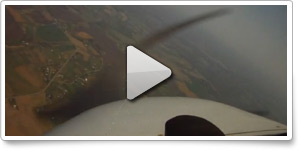 Getting bored with simulated emergencies in which your flight instructor pulls the power over the airport? For a different twist on a standard exercise, watch and see what happens as AOPA Online Managing Editor Alyssa Miller and her flight instructor determine a safe altitude that would allow them to turn back to the airport in the event of an engine failure. How much altitude will they lose between the time that the prop “stops” and they flare to stop the sink rate? Watch AOPA Live® >> Getting bored with simulated emergencies in which your flight instructor pulls the power over the airport? For a different twist on a standard exercise, watch and see what happens as AOPA Online Managing Editor Alyssa Miller and her flight instructor determine a safe altitude that would allow them to turn back to the airport in the event of an engine failure. How much altitude will they lose between the time that the prop “stops” and they flare to stop the sink rate? Watch AOPA Live® >> Career Pilot  FAA issues final rule on pilot fatigue FAA issues final rule on pilot fatigue The FAA on Dec. 21 issued a final rule that overhauls commercial passenger airline pilot scheduling. The new rule sets different requirements for pilot flight time, duty period, and rest, based on the time of day that pilots begin their first flight, the number of scheduled flight segments, and the number of time zones they cross. The rule’s intent is to ensure that pilots have a longer opportunity to rest before they enter the cockpit. Fatigue was cited as a factor in the February 2009 crash of Colgan Air Flight 3407 outside Buffalo, N.Y. Southwest pilots’ retirement plan ranks high Southwest Airlines pilots’ retirement plan took home top honors among a list of plans ranked by financial analysts BrightScope Inc. The Section 401(k) plan for pilots ranked first among 30 plans with assets of more than $1 billion. The plans were evaluated and ranked according to factors such as company contributions, plan eligibility, vesting, fees, and participation rates. The United Airlines pilots’ retirement plan scored the No. 5 spot. Plane Spotter Pilatus PC-12: Long-nosed flier 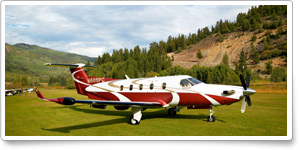 Here’s a trick of the plane spotter’s trade. If you see a largish single-engine aircraft with an extremely long nose and a many-bladed propeller taxi onto the ramp, it’s probably a turboprop. One of the usual suspects is the Pilatus PC-12, a 270-knot flier that is 47 feet long, 14 feet high, can weigh 10,450 pounds at takeoff, and seats 11, or can haul freight. Why the long nose? Turboprop engines provide power at light weight. Center of gravity requirements mean mounting the engine “way out front” on the nose. Here’s a trick of the plane spotter’s trade. If you see a largish single-engine aircraft with an extremely long nose and a many-bladed propeller taxi onto the ramp, it’s probably a turboprop. One of the usual suspects is the Pilatus PC-12, a 270-knot flier that is 47 feet long, 14 feet high, can weigh 10,450 pounds at takeoff, and seats 11, or can haul freight. Why the long nose? Turboprop engines provide power at light weight. Center of gravity requirements mean mounting the engine “way out front” on the nose. Training Products ‘Sporty’s Complete Solo Course’ If you can solo an airplane, you’ve made a huge accomplishment. Sporty’s new DVD course lays out the requirements via six hours of video on three DVDs. The course includes in-flight footage, 3-D animations, interactive on-screen review questions, and Air Facts segments with Richard Collins. The price is $65, and it includes a coupon worth $65 toward the cost of Sporty’s Complete Learn to Fly Course for the recreational or private pilot certificates. Order online or call 800/776-7897 (800-SPORTYS). Note: Products listed have not been evaluated by ePilot editors unless otherwise noted. AOPA assumes no responsibility for products or services listed or for claims or actions by manufacturers or vendors. Member Benefits Did you get an iPad over the holidays? If one of your holiday gifts was an Apple iPad, you can use it to read your AOPA magazine online. First, become a digital subscriber to AOPA Pilot and/or Flight Training magazine. Follow the instructions in your confirmation email to activate your subscription. Then, view the video and download the free AOPA Mags app. After you log in, you can download your magazine(s) for effortless offline reading—and videos and other extended content are just a tap away. Questions or problems? Read our frequently asked questions. Are your insurance policies overdue for their annual inspection? As another year comes to a close, it’s the perfect time to review your insurance policies. A lot can happen in a year, and your coverage needs may have changed. You may even find that it’s time to shop around for better rates. If so, as a pilot, AOPA should be the natural first stop for you. AOPA offers great rates on everything from term life insurance to accidental death and dismemberment insurance to aircraft insurance to auto insurance, and more. Because they are AOPA certified, you won’t have to pay higher rates just for being a pilot. Make sure when you take your first flight of 2012 you can relax and enjoy the flight knowing that you’re covered by AOPA’s Insurance Services. Blogs My best flight Flight Training Deputy Editor Ian Twombly wants to know what your most interesting flight was in 2011, and describes his in this week’s Flight Training blog. Direct Dyersburg Evan Krueger takes his first night flight in more than a year, shows off an Android app called GPSLogger, and discusses the black hole effect in the Let’s Go Flying blog.  | Bose® A20® Aviation Headset The best we've ever made
Bose was the first to introduce active noise reducing headsets to aviation more than 20 years ago, forever changing the way pilots fly. Today, we continue to set the standard with the Bose A20 Aviation Headset. The headset provides acclaimed noise reduction, with a comfortable fit and the clear audio you expect from Bose. It also features Bluetooth® connectivity, an auxiliary audio input and priority switching Learn more > | AOPA Career Opportunities Ever dream of turning your passion for aviation into a career? We’re looking for a director of corporate finance, manager of flight training programs, online product manager, AOPA Live producer/videojournalist, associate editor–Web/ ePilot, and aviation technical specialist. To learn more about other AOPA career opportunities, visit AOPA Online. Community AVIATION EVENTS & WEATHER | 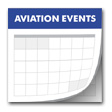 Want something to do this weekend? Planning an aviation getaway? See your personalized online calendar of events . We’ve enhanced our calendar so that with one click you can see all of the events listed in the regions you selected when personalizing ePilot . Now you can browse events in your region to make planning easier. You can also bookmark the personalized calendar page to check it as often as you want. Before you take off on an adventure, make sure you check our current aviation weather provided by Jeppesen. Want something to do this weekend? Planning an aviation getaway? See your personalized online calendar of events . We’ve enhanced our calendar so that with one click you can see all of the events listed in the regions you selected when personalizing ePilot . Now you can browse events in your region to make planning easier. You can also bookmark the personalized calendar page to check it as often as you want. Before you take off on an adventure, make sure you check our current aviation weather provided by Jeppesen. To include an event or to search all events in the calendar, visit AOPA Online. For airport details, including FBO fuel prices, see AOPA Airports. | Final Exam Question: I have been talking with my optometrist about getting contact lenses. Could you clarify what kinds of lenses are allowed by the FAA for flying? Answer: Sure, your question is a common one. Contact lenses that correct each eye for distant vision only, as well as bifocal and multifocal lenses, are acceptable to meet the vision standards for all classes of medical certificates. Contact lenses that correct for near vision only, or wearing one lens in one eye to correct for near vision and the other lens to correct for distance, are not acceptable and do not meet the FAA standards. For more information, see AOPA’s subject report. Got a question for our technical services staff? Email [email protected] or call the Pilot Information Center, 800/872-2672. Don’t forget the online archive of “Final Exam” questions and answers, searchable by keyword or topic.  | Enjoy a little extra peace of mind. Add a FliteLevel Select Extended Warranty™ for your Garmin Avionics Equipment.
Get the protection you need at the price you can afford. Give your aircraft the safety-net and cost-controlling advantages of complete system-wide maintenance protection from cockpit displays to remote LRUs. Learn more. | Instrument Tip  IFR Fix: Ready or not IFR Fix: Ready or not 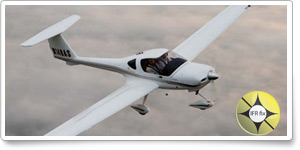 Earning the instrument rating was intense. Now it’s nice to climb into the FBO’s everyday rental ship and just take folks up. No gray glasses today. This ride is all about hamburgers and picture-taking. Yep, here’s basic flying as it was meant to be. Suspicious? This isn’t a column about cooking or photography, after all. So here’s the catch: low clouds and fog. They haven’t reached your destination yet, but they’re moving in fast on a wet south breeze. Read more >> Earning the instrument rating was intense. Now it’s nice to climb into the FBO’s everyday rental ship and just take folks up. No gray glasses today. This ride is all about hamburgers and picture-taking. Yep, here’s basic flying as it was meant to be. Suspicious? This isn’t a column about cooking or photography, after all. So here’s the catch: low clouds and fog. They haven’t reached your destination yet, but they’re moving in fast on a wet south breeze. Read more >> SPIFR, anyone? If you’re working toward your instrument rating, you may wonder if it’s safe to fly single-pilot IFR (SPIFR). It can be, with careful preparation and an honest evaluation of your proficiency level. After all, without a co-pilot or cabin crew, you’ll have a lot on your plate: aviate, navigate, communicate, and program avionics—and with passengers along, you’ll be their flight attendant as well. Take the Air Safety Institute’s Single-Pilot IFR online course to understand what it will mean to fly solo IFR. You’ll learn how to constantly balance risks with skills, equipment, and knowledge. Take the course >> Flight Instructor Refresher Clinics | Air Safety Institute Safety Seminars | Jan. 7 and 8 Baltimore, Md. Ypsilanti, Mich. Portland, Ore. San Antonio, Texas | Jan. 14 and 15 Long Beach, Calif. Jackson, Miss. Charlotte, N.C. | Jan. 21 and 22 San Jose, Calif. Bellevue, Wash. | Jan. 28 and 29 Sevierville, Tenn. | For a complete schedule, see AOPA Online. Can’t make it in person? Sign up for the CFI Refresher Online. | Jan. 9 Mesa, Ariz. Reno, Nev. | Jan. 10 Tucson, Ariz. Sacramento, Calif. | Jan. 11 Milpitas, Calif. El Paso, Texas | Jan. 12 Santa Rosa, Calif. Albuquerque, N.M. | Topics vary—for details and a complete schedule, see AOPA Online. | | |




 What is the first thing you’d do if a passenger became ill during a flight? What’s the correct first reaction if you see a low oil-pressure indication or experience an inadvertent cloud penetration? What if the baggage door pops open on takeoff, or if the engine suddenly begins to crackle and sputter during a night cross-country?
What is the first thing you’d do if a passenger became ill during a flight? What’s the correct first reaction if you see a low oil-pressure indication or experience an inadvertent cloud penetration? What if the baggage door pops open on takeoff, or if the engine suddenly begins to crackle and sputter during a night cross-country?

